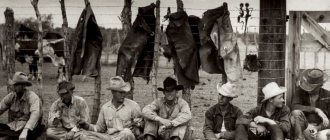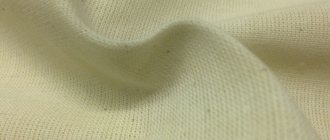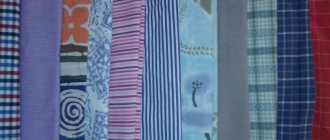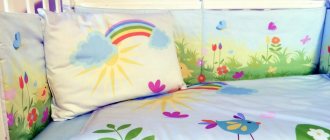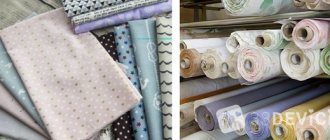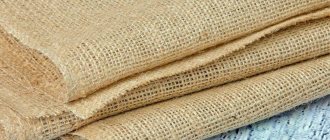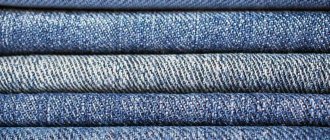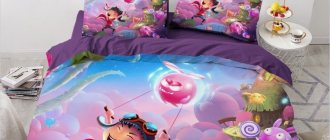What type of fabric is this
Greta is a mixed type of fabric, the inside side is natural, and the outside is synthetic. It is dense, but not heavy, holds its shape perfectly and hardly wrinkles. This material is produced in Belarusian factories and textile enterprises in China.
Greta colors
During the production process, the fibers are intertwined in such a way that the front part is synthetic and the back part is natural. Special impregnations are applied to the fabric to improve its protective properties. The canvases are painted in different shades, including those with printed patterns.
Recommendations for caring for fiber products
One of the main advantages, unlike moleskin and duspo fabric, is its low maintenance requirements. The top layer of the fabric is very durable, does not deform when worn, and does not accumulate dirt. This ensures hassle-free washing, including dry cleaning; the fabric does not require ironing, due to the fact that it practically does not wrinkle.
To remove contaminants, you can use conventional detergents, manual or machine mode.
When drying, it is advisable to avoid direct sunlight to prevent color fading.
The only significant note will be the impossibility of using chlorine-based bleaches. Exposure to an aggressive environment can not only damage the material, but also wash away the protective impregnations.
Pros and cons of fabric
Greta advantages:
- does not tear or wear out;
- the color does not fade even with intensive use;
- air circulation occurs due to the natural fibers in the composition;
- perfectly protects from wind and moisture;
- light weight, even with high density, makes clothing comfortable;
- not demanding in care;
- wide color variety;
- does not wrinkle even with prolonged wear;
- its cost is relatively low;
- The service life is quite long.
Along with the advantages, Greta also has several disadvantages:
- difficulties during cutting;
- the rough structure of the material makes it impossible to sew everyday clothes from it;
- Not sold in all stores.
Technical and physical descriptions
Any dye applies easily to it and lasts a long time, so the fabric can be of different colors to suit every taste. Does not shrink, does not fade after washing, and also holds up well in the sun.
You might be interested in All about cloth and fabrics for billiard tables
Greta combines the advantages of cotton and polyester well. The main technical parameters include:
- Tenderness and ease of use;
- Beautiful appearance with some shine;
- Not heavy, the body breathes;
- Hygienic and hygroscopic;
- Does not get wet;
- Keeps its appearance and does not stretch;
- Resistant and durable;
- Withstands constant use;
- Does not require special care and does not wrinkle;
- Does not shrink when washed and does not fade;
- Hypoallergenic.
An example of strength (leather zam on the left, gretta on the right)
There are also special qualities due to impregnation:
- Does not allow moisture to pass through;
- Repels dirt;
- Wind protection;
- Prevents oil particles from getting on the body;
- Doesn't ignite from a spark.
Camouflage
Greta fabric - consists of a mixture of cotton and polyester, which has become very beneficial in terms of application and its benefits, appreciated by customers. Things made from this fabric can be worn for a long time, and they will also look new.
When washed, things do not change in size or appearance. The cotton inner side of the material is comfortable to the body and does not cause sweating. The synthetic upper gives the material a beautiful, subtle sheen. Dirty items made from this fabric can be easily washed. And dust can be removed even with a dry brush.
What standards are used in production? What do they take into account?
The greta material complies with the standards of GOST 29222-91 “Cloak fabrics made of chemical fibers and mixed”. It determines the standards for fabrics made from a mixture of synthetics and cotton used for sewing raincoats, jackets and sportswear. According to GOST, fabrics must meet standards for physical and mechanical parameters, such as breaking load, pillability, water resistance, frayability, and crease resistance.
In addition, GOST specifies standards for the color fastness of fabrics and their density.
Sports and tourism
The fabric is used to create clothing for fishermen and men who lead an active lifestyle: fishermen, hunters, wildlife lovers. It is well used in sewing sports equipment and clothing for outdoor activities.
Gretta tent
Tents, backpacks, cases for weapons, knives, and fishing chairs are made from it. Used to create shoes, gloves and baseball caps. Pants and tops are worn in everyday life at dacha work. Also used for furniture upholstery. It does not collect dust, is easy to clean and does not allow moisture to pass through. Car covers are made from it.
You might be interested in Description of the composition of Milano fabric: features and application
Application area
Basically, greta is a material for sewing a variety of work or service clothing. Such products last a long time and do not require complex care. For example, a Greta suit can be used by security guards, special forces, military personnel, emergency workers, rescuers or security forces.
Similar Delta Greta suits are intended for civilian purposes. They wear them for hiking, fishing or hunting. Typically, for such products, a type of greta “camouflage” fabric (“khaki”, “jungle”, “winter”, etc.) is used. Monochromatic models in blue, black and other colors are less common.
In addition to military workwear, Greta fabric is used to make signal vests, various summer overalls for road services or construction workers, dressing gowns and much more. Thick Greta raincoat fabric, plain or camouflage, is suitable for making tents and duffel bags. Insulated jackets and ski sports suits are made from it. Often the markings on such products indicate “tisi” (English TC), which means “mixed fabric”.
Among the special-purpose clothing models made from greta, the most popular and comfortable ones have already appeared. For example, the suits “Favorite” (summer, work, gray, consists of a jacket and overalls) and “Gorka” (also summer, similar equipment, but camouflage colors). The Itr suit is similar to the last model, but it consists of a jacket and trousers. The listed products are distinguished by a comfortable fit and good performance properties.
Greta is often found in furniture upholstery materials. It is practical, lasts a long time, does not require complex maintenance, and looks stylish in the interior. As a rule, monochromatic colors are used for such purposes. Printed fabric with patterns is much less common. Unlike traditional furniture coverings, greta is easy to use. It is easy to clean. It practically does not tear and retains its beautiful appearance for a long time.
Properties
The material holds the dye well. Therefore, Greta can be painted in almost any color. Clothes will hold color well when washed and in the sun.
Modern material has all the advantages that cotton and polyester have. Main technical characteristics of the Greta:
- hygiene;
- hygroscopicity;
- removes excess moisture from the body;
- soft, pleasant to the body;
- does not cause allergies;
- attractive appearance, light shine;
- keeps its shape: does not shrink or stretch;
- ease of care.
Varieties
Experts distinguish types of greta fabric according to technical characteristics:
- density;
- coloring;
- finishing method.
The dyeing method divides the fabric into:
- plain painted;
- printed (KMF, or camouflage, denim).
Production of 4 types of greta is available:
- Classic.
- Greta-M. Contains electrically conductive fibers. Has anti-electrostatic characteristics.
- Greta-P. The density differs from the original composition.
- Greta-P premium. Impregnated with water-repellent agent.
The density of the material ranges from 110 to 290 g per square meter. m of canvas. The most in demand is 170-220 g per square meter. m.
Advantages and uses of fabric
Greta is usually used to make workwear: overalls, jackets, trousers, hats. Durable, moisture-proof suits are often used by law enforcement services, police, military, and rescue workers.
Who else could use things made from this fabric?
- Fishermen, tourists, hunters. The material is used to make not only clothes, but also other accessories: tents, folding tables and chairs, backpacks, covers.
- Durable, dirt- and water-repellent uniforms are issued to utility workers, shop workers, power engineers, service personnel, and kitchen workers. If necessary, the impregnation is not just water-repellent, but oil- and petrol-resistant.
On a note
There is a special type of Greta - Greta-M. It does not accumulate static electricity. This is because electrically conductive threads were added to it at the production stage. It can protect against accidental sparks. This variety is used for sewing clothes for hazardous industries.
The choice of material for sewing workwear is explained by its following advantages.
- Does not allow water to pass through and repels dirt.
- Does not require careful care.
- Strong, durable, wear-resistant. Items made from this fabric do not fade, fade little in the sun, do not shrink, and do not stretch. Greta looks good even after active use.
- Resistant to external damage and abrasion.
The area of application explains the specific color scheme of the greta. The most common fabrics are khaki, gray, dark blue, black, and camouflage.
Application for workwear
Greta fabric is used for the manufacture of workwear and uniforms in various industries .
It is used to make clothes for various law enforcement agencies, security companies, employees of the Ministry of Internal Affairs, and the Ministry of Emergency Situations. Its excellent protective qualities and ability to keep its shape well are suitable for wearing in all weather conditions and without the particular need for frequent washing, ironing and ironing.
Clothing made from this fabric is successfully used in the food industry, food outlets, shops, hairdressers and other service facilities. This is facilitated by its hypoallergenicity, good air exchange ability, internal absorbent surface and excellent hygienic qualities .
Types of Greta with special finishes are used in oil and gas, energy enterprises , and the nuclear industry. Clothing with antistatic trim protects a person from the accumulation of static electricity and the possibility of fire from a spark.
It is capable of repelling particles of various petroleum products, oils, mixtures and is necessary in hot shops due to its good protection against sweating.
It also has acid-protective properties. Its dirt-repellent and water-repellent properties are used in the national economy. Farmers are happy to wear such products. It does not need frequent washing and protects against rain, snow, wind and dirt .
Clothing is made for utility workers, construction workers, road workers , and protective vests for specialists in various services. Uniforms are ordered for individual organizations involved in difficult work in different conditions and climates.
Properties and characteristics of Greta fabric
Greta material is mixed. The basis of the textile is a combination of cotton and polyester fibers. The weaving method is twill with a diagonal rib. Standard component ratio: 55% cotton, 45% polyester.
Greta fabric has interesting characteristics: the back side is cotton, the front side is synthetic. The top layer is treated with additional impregnations to increase wear resistance and protective properties.
Since the material is breathable, things made from it are suitable for wearing in winter and summer.
Care
Greta is easy to care for. It should be washed in a machine at a temperature of 30 to 50 degrees. It is better not to make the water too hot. Cotton and polyester will hold up, but the water-repellent impregnation may lose its properties.
Iron clothes made from heated iron with a sole temperature of no more than 1200. You can avoid ironing altogether: due to the large percentage of synthetics, the material wrinkles slightly. After washing, wring out the items on a gentle cycle, shake and straighten them, or hang them wet.
Chlorine-containing bleaches are strictly contraindicated. They will destroy the external impregnation, and the fabric will lose its protective properties.
So, greta is a strong and durable fabric made from a mixture of cotton and polyester. The properties achieved by technologists have made it indispensable for sewing workwear.
